Podcast
Questions and Answers
What was the primary goal of Germany in the early stages of the Battle of the Atlantic?
What was the primary goal of Germany in the early stages of the Battle of the Atlantic?
- To prevent the United States from entering the war.
- To sink Allied warships and disrupt their supply lines. (correct)
- To attack and occupy British territories in the Atlantic.
- To establish naval dominance in the Atlantic.
Which of the following actions did the United States take to support Britain during the Battle of the Atlantic?
Which of the following actions did the United States take to support Britain during the Battle of the Atlantic?
- Invading Germany to open a western front and relieve pressure on Britain.
- Providing direct military aid to Britain before entering the war. (correct)
- Imposing economic sanctions on Germany and its allies.
- Declaring war on Germany immediately after the outbreak of the war in Europe.
What was the significance of the "Two-Ocean Navy" legislation passed in the summer of 1940?
What was the significance of the "Two-Ocean Navy" legislation passed in the summer of 1940?
- It allowed the United States to join the League of Nations and participate in international affairs.
- It provided the necessary funds to build up a powerful air force.
- It was a declaration of war on Germany and its allies.
- It formalized the United States' strategy to focus on both the Atlantic and Pacific theaters of war. (correct)
What was the primary reason for the United States occupying bases in Greenland and Iceland in 1941?
What was the primary reason for the United States occupying bases in Greenland and Iceland in 1941?
What was the significance of the incident involving the U.S. destroyer Greer and a German submarine in September 1941?
What was the significance of the incident involving the U.S. destroyer Greer and a German submarine in September 1941?
What was the primary challenge faced by the United States Navy during the second phase of the Battle of the Atlantic?
What was the primary challenge faced by the United States Navy during the second phase of the Battle of the Atlantic?
What does the passage suggest about the role of the Battle of the Atlantic in World War II?
What does the passage suggest about the role of the Battle of the Atlantic in World War II?
What is the main idea of this passage?
What is the main idea of this passage?
What was one key advantage that the Allies had over the German U-boats during World War II?
What was one key advantage that the Allies had over the German U-boats during World War II?
What was a key challenge faced by the Allies in the early stages of the Battle of the Atlantic?
What was a key challenge faced by the Allies in the early stages of the Battle of the Atlantic?
What was a common tactic used by Allies to protect merchant ships from German U-boats during World War II?
What was a common tactic used by Allies to protect merchant ships from German U-boats during World War II?
What is the main point of the section about sonar and radar?
What is the main point of the section about sonar and radar?
Which of the following statements BEST summarizes the main idea of the first paragraph?
Which of the following statements BEST summarizes the main idea of the first paragraph?
Why did the Allies have an advantage in planning their land campaigns in Europe?
Why did the Allies have an advantage in planning their land campaigns in Europe?
What does the text suggest was a common mistake made by some naval leaders in both World War I and World War II?
What does the text suggest was a common mistake made by some naval leaders in both World War I and World War II?
What is the main purpose of the text?
What is the main purpose of the text?
Which of the following is NOT a source cited in the provided list of sources?
Which of the following is NOT a source cited in the provided list of sources?
Which author explored the U.S. Navy's role in European Waters during World War I?
Which author explored the U.S. Navy's role in European Waters during World War I?
Which publication focuses on the Battle of the Atlantic across a 50 year span?
Which publication focuses on the Battle of the Atlantic across a 50 year span?
Which author provided an analysis of the Battle of the Atlantic from a specifically American perspective?
Which author provided an analysis of the Battle of the Atlantic from a specifically American perspective?
Which publication includes a chapter dedicated to the dramatic true story of Germany's first U-boat attacks along the American coast in World War II?
Which publication includes a chapter dedicated to the dramatic true story of Germany's first U-boat attacks along the American coast in World War II?
What was the primary reason for the success of German submarines in Operation Drumbeat?
What was the primary reason for the success of German submarines in Operation Drumbeat?
What significant action did the United States Navy take to counter the German submarine threat on the East Coast?
What significant action did the United States Navy take to counter the German submarine threat on the East Coast?
What strategy did the German submarines adopt after facing increased resistance from the American Navy?
What strategy did the German submarines adopt after facing increased resistance from the American Navy?
What were the significant impacts of the Tenth Fleet’s formation on the ongoing anti-submarine efforts in the Atlantic?
What were the significant impacts of the Tenth Fleet’s formation on the ongoing anti-submarine efforts in the Atlantic?
What factor significantly aided the Allied efforts in combating the German submarine threat in the Atlantic?
What factor significantly aided the Allied efforts in combating the German submarine threat in the Atlantic?
What was the main reason for the shift in the balance of power in the Atlantic during 1943?
What was the main reason for the shift in the balance of power in the Atlantic during 1943?
What is the significance of the phrase “happy time” as used in the text, in reference to German submarines?
What is the significance of the phrase “happy time” as used in the text, in reference to German submarines?
How did American industrial production contribute to the Allied victory in the Atlantic?
How did American industrial production contribute to the Allied victory in the Atlantic?
Flashcards
Battle of the Atlantic
Battle of the Atlantic
A crucial naval campaign during World War II focused on controlling the Atlantic shipping routes.
U-boats
U-boats
German submarines used to disrupt Allied shipping during the Battle of the Atlantic.
Lend-Lease Act
Lend-Lease Act
A U.S. program to supply Allied nations with war materials in exchange for future payments.
Two-Ocean Navy
Two-Ocean Navy
Signup and view all the flashcards
President Roosevelt's Destroyer Deal
President Roosevelt's Destroyer Deal
Signup and view all the flashcards
Greer Incident
Greer Incident
Signup and view all the flashcards
Reuben James
Reuben James
Signup and view all the flashcards
Navy readiness
Navy readiness
Signup and view all the flashcards
Operation Drumbeat
Operation Drumbeat
Signup and view all the flashcards
Cyclops
Cyclops
Signup and view all the flashcards
Convoy System
Convoy System
Signup and view all the flashcards
Admiral Ernest J. King
Admiral Ernest J. King
Signup and view all the flashcards
Tenth Fleet
Tenth Fleet
Signup and view all the flashcards
Radar Technology
Radar Technology
Signup and view all the flashcards
Intelligence Operations
Intelligence Operations
Signup and view all the flashcards
Liberty Ships
Liberty Ships
Signup and view all the flashcards
U-Boat Attacks
U-Boat Attacks
Signup and view all the flashcards
Naval Operations in WWII
Naval Operations in WWII
Signup and view all the flashcards
Naval Institute Press
Naval Institute Press
Signup and view all the flashcards
German U-boat crews
German U-boat crews
Signup and view all the flashcards
Allied advantage
Allied advantage
Signup and view all the flashcards
Escorted convoys
Escorted convoys
Signup and view all the flashcards
Defensive vs Offensive strategy
Defensive vs Offensive strategy
Signup and view all the flashcards
Sonar and radar technology
Sonar and radar technology
Signup and view all the flashcards
Training with technology
Training with technology
Signup and view all the flashcards
Unpreparedness in early conflict
Unpreparedness in early conflict
Signup and view all the flashcards
Study Notes
Battle of the Atlantic Overview
- Germany, in September 1939, sought to exploit Britain's reliance on imported food and materials.
- The Allies (US, British, and Canadian Navies) collaborated to counter German U-boats and Luftwaffe bombers.
- Victory in the Battle of the Atlantic wasn't achieved until 1943.
- The struggle was divided into three phases.
Phase 1: Pre-War and Early War
- U.S. maintained neutrality but increased fleet preparedness
- Roosevelt arranged a destroyer exchange for British bases.
- Lend-Lease Act enabled Britain to receive vital equipment.
- U.S. occupied Greenland and Iceland.
- Germany initially avoided direct conflict with the U.S. Navy.
- Tension escalated with incidents like the sinking of the Greer and Reuben James.
Phase 2: U-Boat Offensive
- Germany's U-boats targeted American and Allied vessels off the U.S. East Coast.
- U.S. Navy was unprepared for the intensity of the U-boat assault.
- Insufficient numbers of destroyers and subchasers to escort convoys.
- Limited aircraft coverage.
- U-boats enjoyed a period of success sinking many merchant ships.
Phase 3: Allied Counteroffensive
- Convoys were implemented to improve protection, which forced the U-boats to change tactics.
- Superior Allied scientific and technological innovation (sonar, radar on bombers and escorts).
- Increased numbers of escort carriers and destroyers, increasing the offensive and defensive capabilities.
- Allied intelligence from intercepted German messages helped locate U-boats.
- Increased industrial production of naval vessels (e.g., Liberty ships).
- By mid-1943, the tide turned in favor of the Allies. Allies were better prepared, better equipped, better supported and more organized than they were earlier which enabled them to fight successfully in the battle.
Studying That Suits You
Use AI to generate personalized quizzes and flashcards to suit your learning preferences.




